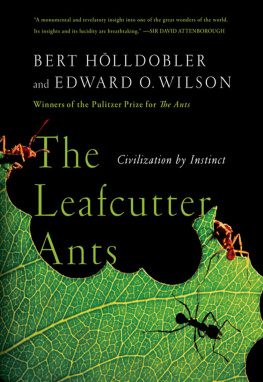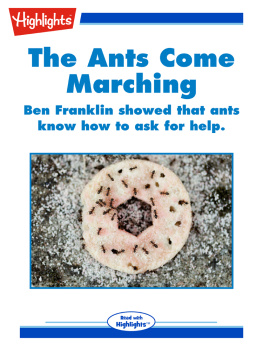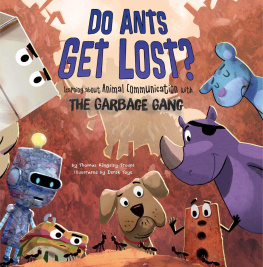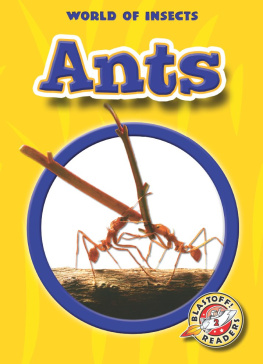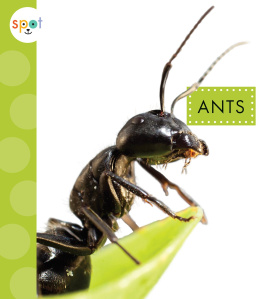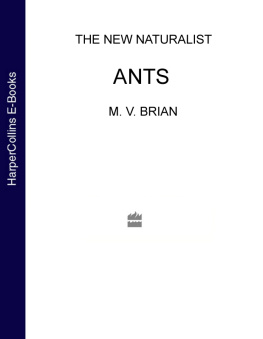BOOKS BY THE AUTHORS
ALSO BY BERT HLLDOBLER AND EDWARD O. WILSON
The Ants (1990); Pulitzer Prize, General Nonfiction, 1991
Journey to the Ants: A Story of Scientific Exploration (1994)
The Superorganism: The Beauty, Elegance, and Strangeness of Insect Societies (2009)
ALSO BY BERT HLLDOBLER
Experimental Behavioral Ecology and Sociobiology, with Martin Lindauer, editors (1985)
Herbivory of Leaf-Cutting Ants: A Case Study on Atta colombica in the Tropical Rainforest of Panama, with Rainer Wirth, Hubert Herz, Ronald J. Ryel, and Wolfram Beyschlag (2003)
ALSO BY EDWARD O. WILSON
The Theory of Island Biogeography, with Robert H. MacArthur (1967); new preface, 2001
A Primer of Population Biology, with William H. Bossert (1971)
The Insect Societies (1971)
Sociobiology: The New Synthesis (1975); new edition, 2000
On Human Nature (1978); Pulitzer Prize, General Nonfiction, 1979
Caste and Ecology in the Social Insects, with George F. Oster (1978)
Genes, Mind, and Culture, with Charles J. Lumsden (1981)
Promethean Fire: Reflections on the Origin of Mind, with Charles J. Lumsden (1983)
Biophilia (1984)
Success and Dominance in Ecosystems: The Case of the Social Insects (1990)
The Diversity of Life (1992)
Naturalist (1994); new edition, 2006
In Search of Nature (1996)
Consilience: The Unity of Knowledge (1998)
Biological Diversity: The Oldest Human Heritage (1999)
The Future of Life (2002)
Pheidole in the New World: A Hyperdiverse Ant Genus (2003)
From So Simple a Beginning: The Four Great Books of Darwin , edited with introductions (2005)
Nature Revealed: Selected Writings, 19492006 (2006)
The Creation: An Appeal to Save Life on Earth (2006)
Anthill: A Novel (2010)

THE
LEAFCUTTER
ANTS
Civilization by Instinct
BERT HLLDOBLER
AND
EDWARD O. WILSON
W. W. NORTON & COMPANY
NEW YORK LONDON
Frontispiece : Diversity of plant fragments collected by one Atta colombica colony in Panama during one year. Artistic arrangement and photograph by Christian Ziegler. ( Christian Ziegler / DanitaDelimont.com.)
Copyright 2011 by Bert Hlldobler and Edward O. Wilson
Parts of this text have previously appeared in Chapter 9 of The Superorganism by Bert Hlldobler and Edward O. Wilson
All rights reserved
For information about permission to reproduce selections from this book, write to Permissions, W. W. Norton & Company, Inc., 500 Fifth Avenue, New York, NY 10110
Library of Congress Cataloging-in-Publication Data
Hlldobler, Bert, 1936
The leafcutter ants: civilization by instinct / Bert Hlldobler and Edward O. Wilson.1st ed.
p. cm.
Includes bibliographical references.
ISBN: 978-0-393-33868-3
1. Leaf-cutting ants. I. Wilson, Edward O. II. Title.
QL568.F7H577 2011
595.79'6dc22
2010016202
W. W. Norton & Company, Inc.
500 Fifth Avenue, New York, N.Y. 10110
www.wwnorton.com
W. W. Norton & Company Ltd.
Castle House, 75/76 Wells Street, London W1T 3QT
LIST OF ILLUSTRATIONS
FIGURES
PLATES
Frontispiece: Diversity of plant fragments harvested by leafcutter ants
PROLOGUE
I f a congress of naturalists were to gather to choose the seven wonders of the animal world, they would be compelled to include the bizarre and mighty civilizations of the attine leafcutters. Throughout the tropical and subtropical regions of the New World, these insects dominate the forests, grasslands, and pastures.
Anywhere you travel on the mainlands of Central and South America, from the wild interior to plazas and vacant lots in the hearts of the cities, you will soon encounter leafcutters. What catches your attention at first are massive lines of relatively large reddish brown worker ants. They run in columns as wide as ten ants abreast, and as tight as soldiers double-timing in a parade. They travel on miniature highways the width of a human hand, which they keep bare of vegetation and debris. Some are outward bound; a roughly equal number are homeward bound. Most among the latter carry a freshly cut section of a leaf or flower petal, which they grip in their mandibles and direct back over their bodies like umbrellas. These are the parasol ants, local people in Texas and Louisiana will tell you.
Look closely at the burdened ants, and you are likely to see pygmy replicas riding as hitchhikers on the transported leaf fragments. Do these miniature ants act like mahouts to guide their big nestmates home? No, their role is even stranger; they serve as living flywhisks. Ant columns attract parasitic flies that are deadly. They descend like dive-bombers and, if unimpeded, lay eggs upon or near the necks of the big ants. The maggots that soon hatch work their way into the bodies of the ants and consume their tissues. The flywhisk guardlings prevent this action by standing on top of their leaf-carrying sisters and striking at the flies with their front legs and swatting mandibles.
If you follow the caravan of laden ants, they will bring you to the nest. It might be fifty or even more than a hundred meters down the trail. The trip may take you through dense under-growth, and perhaps a steep little ravine or two. Inevitably and often suddenly, the nest comes into view. It is a city of millions, a subterranean metropolis. Above it is a circular dome of excavated soil that rises two meters or more. In the underground, the ants have excavated thousands of chambers, roughly the size of a human head, more precisely from a thirtieth of a liter to fifty liters in volume. All are connected by a labyrinth of tunnels. The chambers are filled with a fluffy gray mass. Their thin walls are built to create a maximum of surface per unit of volume. Upon the walls grows a species of fungus that exists exclusively in symbiosis with agricultural ants such as the leafcutters and their evolutionarily less advanced close relatives. The fungus only rarely develops a mushroom with a stalk and cap. Instead, it proliferates in the form of mats of threadlike hyphae.
The walls of the cells upon which the fungus feeds are built from a paste, like papier-mch. This substance is manufactured from the fragments of vegetation brought in by the foraging workers.
Aside from plant sap obtained from freshly cut vegetation, the leafcutters subsist entirely on the cultivated fungus. They have invented a method of converting fresh vegetation, a material the digestive system of ants cannot handle, into an edible food product. The leafcutter ants are partly comparable in achievement to that of human agriculturists. And they have attained a breakthrough of organic evolution: by utilizing fresh vegetation on which to grow their crops, they have tapped into a virtually unlimited food source.
The interdependence of the leafcutters and their fungus is one of the most successful symbioses of all time. The ants are the principal consumers of living plant material and therefore a dominant force in the land environments of the American tropics. A full-grown colony consumes approximately the same quantity of plant material as a cow. Through much of tropical America and wherever the ants can invade gardens and cropland, they are the principal insect pests of agriculture.
And so all within their great range know them. They are the sava of Brazil, isa of Paraguay, cushi of Guyana, zampopo of Costa Rica, wee-wee of Nicaragua and Belize, cuatalata of Mexico, bibijagua of Cuba, and town ant or parasol ant of Texas and Louisiana.

